(Strand)om Stories: Iron Man Epic Collection: Return of the Ghost Review
This Epic Collection offers entertaining if not comfortable narratives slotted between stories featuring unique artistic showcases
—by Nathan on April 11, 2025—
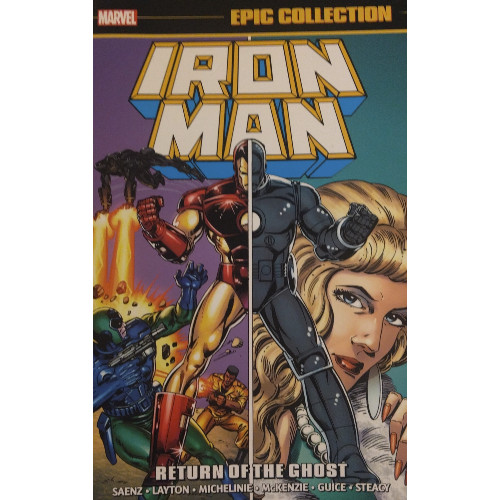
In my third-ever "(Strand)om Stories" post, reviewing an Epic Collection which covered the entire "Stark Wars" (otherwise known as "Armor Wars," to calm down George Lucas fans) saga, I wrote in my concluding paragraph: "I do feel somewhat compelled to read what comes next in Iron Man, just to see how fully [David] Michelinie caps the arc, but until that day arrives, I'm satisfied."
I guess "somewhat compelled" quickly fizzled, because I fell on the lower end of that scale; it's been over four years since that review, and I'm only getting to the issues immediately following "Stark Wars" now. Let's blame all the other fantastic stories I've been reading and reviewing during that time.
But the day I spoke of has arrived. We're finally fitting on our rocket-powered jet boots and soaring into these stories.
For the uninitiated or forgetful: "Stark Wars" was a narrative which saw Tony Stark learn much of his technology had been commandeered by other parties and incorporated, against his wishes, not only into government exosuits like the Guardsmen and Mandroids but foreign powers such as Crimson Dynamo and Titanium Man and straight up villains like Stilt Man and the Beetle. Tony went to war on these individuals, destroying his own tech and winding up on the wrong side of the government, eventually fighting Steve "The Captain" Rogers and Firepower. Tony faked Iron Man's death, insinuating that his "bodyguard" had gone rogue and died as a result, before debuting a "new" Iron Man, complete with a brand new look. Shiny, sleek, golden, modern.
This is where we pick up, in the aftermath of a PR nightmare for Tony and his company, with Shellhead needing to prove himself in the face of public scrutiny.
Let's hope he's better than the "last" guy!
Iron Man Epic Collection: Return of the Ghost
Writers: Mike Saenz, David Michelinie, Bob Layton, Ken Steacy, and Roger McKenzie
Pencilers: Mike Saenz, Butch Guice, Denys Cowan, Alan Kupperberg, Bob Layton, Ken Steacy, Harry Candelario, Bob Downs, Dave Simons, Marc Siry, Gavin Curties, and James Brock
Inkers: Mike Saenz, Bob Layton, Barry Windsor-Smith, Ken Steacy, Don Hudson, and Chris Ivy
Colorists: Mike Saenz, Bob Sharen, Paul Becton, Marc Siry, and Mike Rockwitz
Letterers: Mike Saenz, Janice Chiang, Ken Seacy, and Andrew Pratt
Issues Collected: Iron Man #233-244, Iron Man: Crash, and Marvel Fanfare #22-23 and #44
Volume Publication Date: December 2022
Issue Publication Dates: September-October 1985, April 1988, August 1988-July 1989
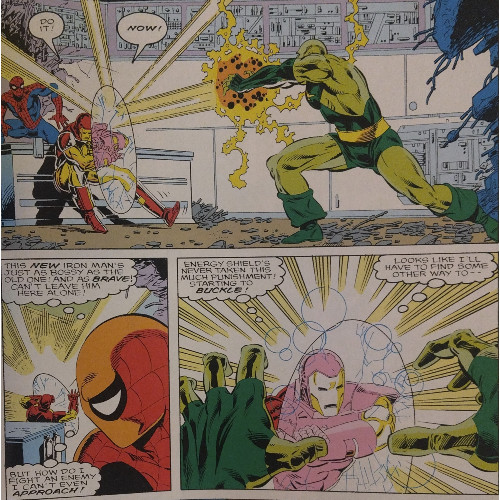
I will get the disappointing stuff outta the way first: there is not as much fallout from "Stark Wars" as I was hoping there would be.
David Michelinie and Bob Layton take a brief amount of time to cover the legal ramifications of the events, with business-suited Tony Stark spending a few scenes chewing out an incompetent legal expert and armored-suited Tony showing off to the public in an effort to curry favor with his "new" Iron Man. But the specifics are brushed over fairly quickly–any legal drama plays out in the background, and few folks make a fuss over the "new" guy in the Iron Man suit. There's little to suggest a running theme of Tony needing to rebuild a reputation damaged by "Stark Wars."
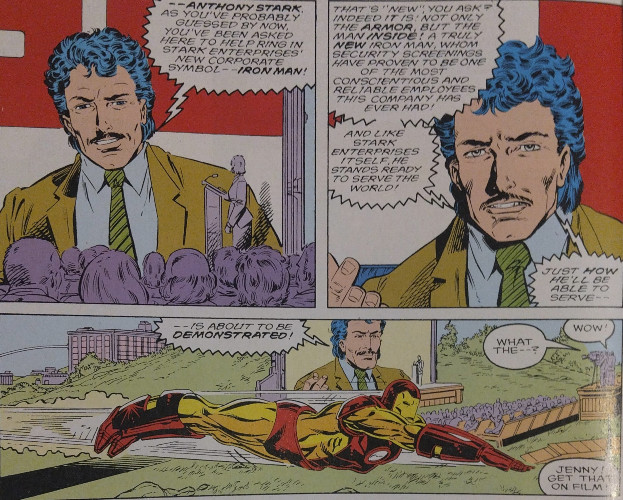
It's a slightly disappointing direction to not take; I was genuinely hoping that the fallout of Iron Man going after supervillains, international and domestic, as well as government agents would play out in serious fashion across at least a handful of issues. We get word of "government lawsuits," but those are handled neatly in a slightly later issue that does feature a clever battle in space between Iron Man and a government experiment gone amuck, but it's too tidy. "Stark Wars" was a bombastic, well-told epic, and I feel it deserved at least a more complicated denouement.
If I'm disappointed with the direction Michelinie doesn't take, I was pleased with the results of the non-"Stark Wars" paths Michelinie has Iron Man coast over. Outside concluding the last volume's fantastic adventure, Michelinie creates some fairly entertaining tales which shift the focus from a massive story covering multiple issues to smaller tales of one to two issues each.
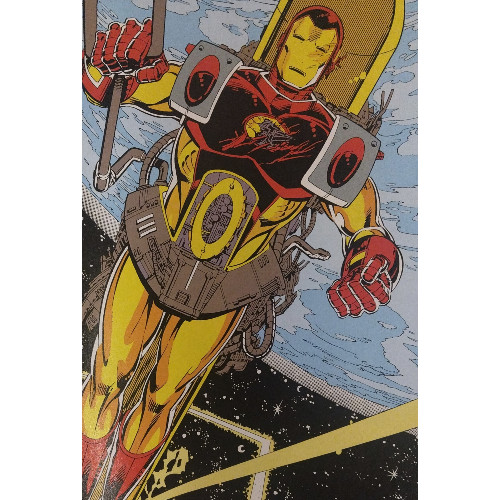
There is a certain "back to basics" feel to the whole volume (which, I will note, has only twelve regular Iron Man issues, thanks to some bonus content I'll discuss later), perhaps a subtle settling from the "Stark Wars" escapade. What you see is generally what you get, nothing too crazy: we have a scheme by Justin Hammer; we have the "usual suspects" of Tony's rogues gallery, including Blizzard, the Ghost, and Whiplash; we're even given a showdown between Tony and the Mandarin late in the volume. Michelinie seems deserving of a break, considering the broad scope of the ongoing events of the last collection, so he takes the pace a bit slower here, throwing in interesting yet common stories to pull the reader along.
The tactic works. I won't complain that some of the issues feel a tad generic, because each narrative scratches that "fun" itch, even if no one will ever call them brilliant. I've been a little critical of Michelinie in my reviews as of late, critiquing some of his early 90s contributions over on the Spidey side of the Marvel Universe. The simple one-liners and cribbed dialogue I found peppering some ASM stories I recently reviewed feel relaxed here, with Michelinie's narratives and dialogue flowing well from scene to scene. This is an easy volume to pour through, and I found myself quickly turning the pages. If you're looking for lighter reading featuring a famous man in an iron can blasting bad guys from here to space, this volume fills that very particular void.
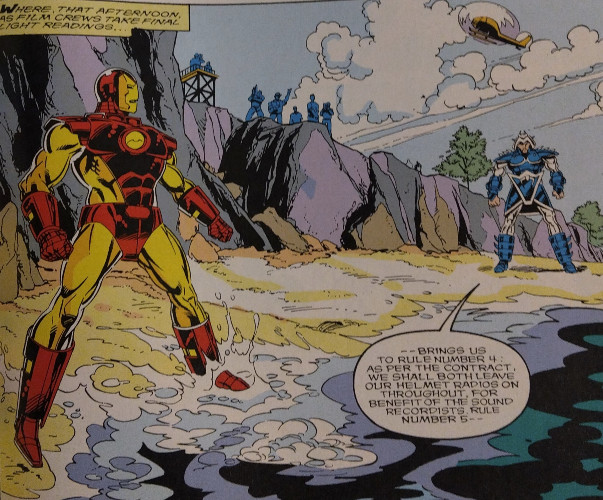
Michelinie's most interesting development is the introduction of Kathleen "Kathy" Dare, who adds a complex wrinkle to the otherwise smooth stories. I knew I recalled the name when she first appeared, though my brain could not remember why. My thoughts clicked late in the volume, right about when another "click" fires a bullet into a very central figure in the story. Kathy develops an obsession with Tony, her actions serving as a prologue to issues I reviewed a while back where Rhodey takes over the company temporarily and dons the War Machine armor.
Michelinie handles Kathy in a manner which is genuinely frightening, generating from a seemingly innocent woman an unhealthy interest in the billionaire superhero. The writer passes her off as someone with gumption and verve, slowly peeling back the layers and showing her as more cunning and dangerous as the issues progress (dare I say…she's psychotic?). I was reminded of how well Michelinie and John Romita Jr. handled the "alcoholic Tony" subplot in "Demon in a Bottle," subtly indicating the undue influence of alcohol and ramping up its effects across several issues. The same can be seen with Kathy here. Part of me wonders if Michelinie used her gender as a weapon, maintaining the slow burn out of some readers' beliefs that a woman wouldn't stalk a man, or perhaps that a man as powerful as Tony Stark couldn't be stalked. In a volume marked by a certain level of routine roughhousing between Iron Man and his standard opponents, Kathy is the x-factor, and as her role grows more significant, Michelinie's subplot ends up holding far more menace than Iron Man's fisticuffs with his foes.
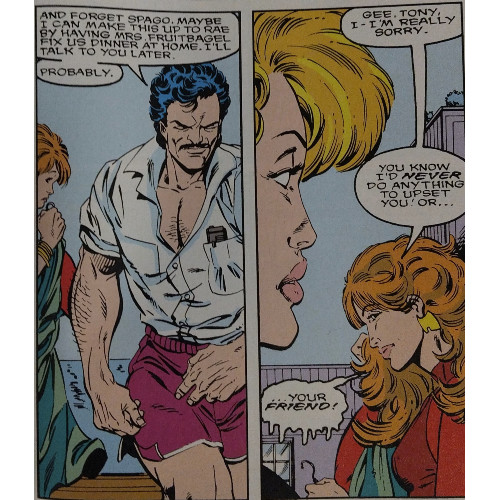
Return of the Ghost opens and ends with non-Michelinie narratives, veering away from the ongoing series into more artistically inclined projects. Iron Man: Crash, written by Mike Saenz, is notable for being the world's first computer generated graphic novel, published under Epic Comics, Marvel's adult-oriented line. Some readers may also be familiar with Saenz's Shatter, which predated Crash by about three years and was also computer generated, though I read the coloring process was handled on Shatter like a traditional comic book, so Crash is the "first" because the full art process happened on a computer.
Crash is a fine enough story, but the appeal is the art, though I may use "appeal" a little loosely. "Novel" may be the better descriptor. 9 times out of 10, the art is rendered by programmer William Bates as fairly consistent and fluid. Action tends to work well, and certain tricks and panel structures are used to maintain the feel of a standard graphic novel. Certain components even look like they were traditionally composed, including decent inking. Periodically, images feel awkward or improperly rendered, and the whole piece was created on machines too primitive to not make it look pixelated. Saenz and Bates used the limited technologies of the times, and save for some odd visual moments, the art conveys the narrative well. The tale told is fine–we're given an older Tony Stark heading out on one final Iron Man mission in Japan–but Saenz gives into some irritating wordiness, particularly in one early "suiting up" scene where words clutter the boxes and don't allow the art to tell the story on its own merits.
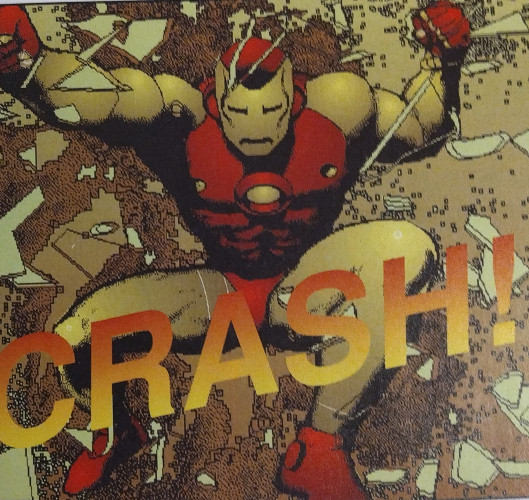
Better handled are a series of Marvel Fanfare issues drawn by Ken Steacy and mostly written by Roger McKenzie. Steacy's art is a jarring transition, particularly as it initially feels (I kid you not) like the kind of design you'd find in Marvel's Super Hero Squad show. I got past that thinking quickly, but Steacy's designs are all cartoon-esque in nature, belaying a few fairly grim issues written by McKenzie. A two-parter seeks to drill at the heart of who Iron Man is, placing him in conflict with Doctor Octopus in the wake of Doc Ock's defeat at the hands of Daredevil in an issue McKenzie also scripted. Again, like Crash, not a bad story, and a single issue follow-up written by Steacy as well has its moments.
So Michelinie's issues are bookended by two distinctively artistic takes on Iron Man…which, in certain ways, could not be more different from each other or the art on the regular series. Bates' computer created pixels offer a gritty, unfinished feel in comparison to Steacy's work, which would feel more at home in work for slightly younger readers. Both styles collide against what we see in the normal issues, which fit neatly within the boundaries of traditional comic art, sort of like the stories they illustrated. We're given an Iron Man sandwich: some artistic stretching, followed by a heaping helping of classic fare, and finished with more artistic liberties.
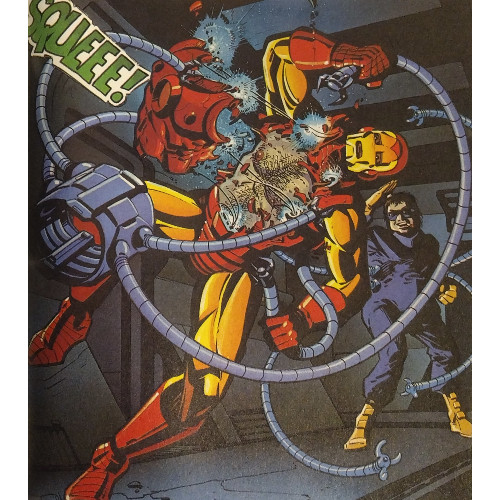
If you're looking for something a bit more unique than standard superhero sequences, go ahead and give this volume a read. Oh, most of it is the same old, same old, and I don't begrudge Michelinie for diving into comfortable waters. He navigates them well, making twelve easily read issues which balance action with heart and provide a remarkably gritty subplot for anyone who enjoys ongoing tension in their comics. Everything here is solid. And though the opening and closing narratives aren't exactly stellar stories, their artistic components should grab the attention and lead the reader through. They're different, experimental in nature, and though not as solid as the material in between, should offer enough of an interest to make this volume a distinctive entry in any reader's collection.